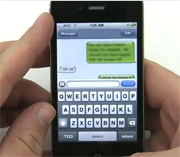
MONDAY, March 10, 2014 (HealthDay News) — Mealtime is supposed to be family time, but a new study suggests that ever-present smartphones are impeding parent-child communication at the table.
Researchers who observed more than 50 family-type groups eating out found a significant number of adults were preoccupied with their smartphones.
“We know from decades of research that face-to-face interactions are important for cognitive, language and emotional development. Before mobile devices existed, mealtime would’ve been a time where we would’ve seen those interactions,” said study author Dr. Jenny Radesky, a fellow in developmental-behavioral pediatrics at Boston Medical Center.
It’s unclear how much of an impact parents’ smartphone use will ultimately have on a child’s development, and whether that effect will have a negative, positive or neutral impact, said the researchers.
One basic thing that may be affected is child vocabulary, said Dr. Rahil Briggs, director of pediatric behavioral health services at Montefiore Medical Center in New York City. “The single most powerful predictor of a child’s vocabulary is conversations with the child. Dinnertime is an important time for those conversations, and if you’re absorbed with your phone, that’s a lost opportunity.”
Briggs added that social, emotional and conversational skills might also be affected if parents spend too much time looking at their phones and other media.
“What really concerned me was those children who appeared to accept this lack of engagement. It seemed like they’d given up,” noted Briggs, who wasn’t involved with the research.
To capture a snapshot of how parents use their phones around their children at mealtime, Radesky and her colleagues visited Boston-area fast food restaurants and observed groups that included at least one adult and one or more children who looked younger than 10. They took detailed notes on how caregivers — which likely included parents, grandparents and babysitters — used their smartphones and how children responded.
They conducted 55 observations last summer. Forty caregivers took out their phones at some point during the meal. A few kept it on the table, but didn’t appear to use it. Another small group kept their phones in their hands while doing other things.
The largest group — 16 caregivers — seemed totally absorbed by their phones, using them continuously, even eating and talking while looking at the phone. In most cases, it appeared the caregivers were using the phones’ keyboards or making swiping motions on the phones rather than making phone calls.
Another nine caregivers used their devices intermittently, and then put the phone away. The researchers said these caregivers appeared to balance use of the device and paying attention to the child or children.
While the adults used their phones, some school-aged children were busy eating, talking to another child or playing with the toy that came with their meal, and didn’t seem concerned that the caregiver was on a device, especially if it was for a short period of time.
When caregivers were completely absorbed with their phones, some children just seemed to accept it. However, many other children started acting up in an attempt to garner the caregivers’ attention.
Some of these caregivers appeared to ignore the child’s behavior for a bit and then scolded them, sometimes without even looking up from the phone.
“Children are going to get X amount of your attention every day. Your best bet is to give that attention in a positive way, or they may start to seek it in a negative way,” said Briggs.
This is an emerging and important field of study, she added. “We’re just learning how to think about exposure to media in small children, and now parents are being distracted by their phones. We can’t turn a blind eye to this present absence,” she said.
Radesky and Briggs agreed that smartphone use isn’t all bad. Sharing apps and games with kids can be a way to connect. And smartphones certainly won’t be going away anytime soon.
“They’re an essential tool. What we need to do is help build guidelines for the healthiest ways to use them,” said Radesky. “It’s important for parents to have ‘off’ time where they tune in only to their child.”
Briggs supports a balanced approach. “My take on tech use for parents and children is everything in moderation,” she said.
More information
For more about media use and children see the American Academy of Pediatrics.
Copyright © 2025 HealthDay. All rights reserved.

